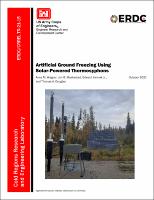Please use this identifier to cite or link to this item:
https://hdl.handle.net/11681/42421Full metadata record
| DC Field | Value | Language |
|---|---|---|
| dc.contributor.author | Wagner, Anna M. | - |
| dc.contributor.author | Maakestad, Jon B. | - |
| dc.contributor.author | Yarmak, Edward | - |
| dc.contributor.author | Douglas, Thomas A. | - |
| dc.date.accessioned | 2021-11-22T15:37:38Z | - |
| dc.date.available | 2021-11-22T15:37:38Z | - |
| dc.date.issued | 2021-10 | - |
| dc.identifier.govdoc | ERDC/CRREL TR-21-15 | - |
| dc.identifier.uri | https://hdl.handle.net/11681/42421 | - |
| dc.identifier.uri | http://dx.doi.org/10.21079/11681/42421 | - |
| dc.description | Technical Report | en_US |
| dc.description.abstract | Thermosyphons are an artificial ground-freezing technique that has been used to stabilize permafrost since the 1960s. The largest engineered structure that uses thermosyphons to maintain frozen ground is the Trans Alaska Pipeline, and it has over 124,000 thermosyphons along its approximately 1300 km route. In passive mode, thermosyphons extract heat from the soil and transfer it to the environment when the air temperature is colder than the ground temperature. This passive technology can promote ground cooling during cold winter months. To address the growing need for maintaining frozen ground as air temperatures increase, we investigated a solar-powered refrigeration unit that could operate a thermosyphon (nonpassive) during temperatures above freezing. Our tests showed that energy generated from the solar array can operate the refrigeration unit and activate the hybrid thermosyphon to artificially cool the soil when air temperatures are above freezing. This technology can be used to expand the application of thermosyphon technology to freeze ground or maintain permafrost, particularly in locations with limited access to line power. | en_US |
| dc.description.sponsorship | United States. Army. Corps of Engineers. | en_US |
| dc.description.tableofcontents | Abstract .......................................................................................................................................................... ii Figures ............................................................................................................................................................ iv Preface ............................................................................................................................................................ vi 1 Introduction ............................................................................................................................................ 1 1.1 Background ..................................................................................................................... 1 1.2 Objective .......................................................................................................................... 5 1.3 Approach ......................................................................................................................... 5 2 Methods and Materials ........................................................................................................................ 6 2.1 Thermosyphon array ....................................................................................................... 6 2.2 Refrigeration ................................................................................................................... 7 2.3 Solar assembly ................................................................................................................ 8 2.4 Temperature monitoring ............................................................................................... 10 3 Results and Discussion .....................................................................................................................13 3.1 Refrigeration unit selection .......................................................................................... 13 3.2 Soil temperatures prior to active cooling ..................................................................... 15 3.3 Artificial cooling in the active phase ............................................................................ 18 4 Conclusions and Recommendations .............................................................................................. 22 References ................................................................................................................................................... 23 Report Documentation Page .................................................................................................................... 25 | - |
| dc.format.extent | 33 pages / 6.44 MB | - |
| dc.format.medium | - | |
| dc.language.iso | en_US | en_US |
| dc.publisher | Cold Regions Research and Engineering Laboratory (U.S.) | en_US |
| dc.publisher | Engineer Research and Development Center (U.S.) | - |
| dc.relation.ispartofseries | Technical Report (Engineer Research and Development Center (U.S.)) ; no. ERDC/CRREL TR-21-15 | - |
| dc.rights | Approved for Public Release; Distribution is Unlimited | - |
| dc.source | This Digital Resource was created in Microsoft Word and Adobe Acrobat | - |
| dc.subject | Artificial ground freezing | en_US |
| dc.subject | Climatic changes | en_US |
| dc.subject | Cold regions | en_US |
| dc.subject | Infrastructure | en_US |
| dc.subject | Permafrost--Stability | en_US |
| dc.subject | Refrigeration | en_US |
| dc.subject | Solar array | en_US |
| dc.subject | Thermosyphons | en_US |
| dc.subject | Warming climate | en_US |
| dc.title | Artificial ground freezing using solar-powered thermosyphons | en_US |
| dc.type | Report | en_US |
| Appears in Collections: | Technical Report | |
Files in This Item:
| File | Description | Size | Format | |
|---|---|---|---|---|
| ERDC-CRREL TR-21-15.pdf | 6.44 MB | Adobe PDF |  View/Open |